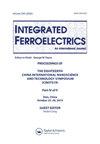Effect of Na + Substitution on the Phase, Microstructure, Electrical and Energy Storage Properties of BSBZNT Ceramics Prepared by the Solid-State Combustion Technique
IF 0.7
4区 工程技术
Q4 ENGINEERING, ELECTRICAL & ELECTRONIC
引用次数: 0
Abstract
Abstract(Ba0.704Sr0.176Bi0.12)1-xZn0.08Nb0.04Ti0.88O3-Nax (BSBZNT-xNa) ceramics with x = 0, 0.01, 0.03 and 0.05 mol%, were prepared by the solid-state combustion technique. The samples were calcined and sintered at 950 °C and 1375 °C, respectively, for 2 h. The phase, microstructure, dielectric, ferroelectric and energy storage properties were investigated. The X-ray diffraction patterns of the BSBZNT-xNa powders showed a perovskite phase for all samples. When x increased from 0-0.03, the average particle size increased from 380 to 480 nm, then decreased to 420 nm. All sintered samples showed the coexistence of the orthorhombic and cubic phases. The average grain size was in the range of 2.03 to 1.39 µm. The BSBZNT-0.01Na ceramic exhibited the highest dielectric properties at room temperature (ɛr = 902, tanδ = 0.10), the lowest remanent polarization (Pr = 0.10 µC/cm2), coercive field (Ec = 0.43 kV/cm), and the highest energy storage efficiency (η ∼ 94.70%) measured under an electric field of 70 kV/cm.Keywords: BSBZNT-xNa ceramicsolid-state combustionphase structuremicrostructureenergy storage AcknowledgmentsThe authors wish thank the Department of Physics, Facullty of Science, Nareasuan University for provision of supporting facilities. Thanks are also given to Dr.Kyle V.Lopin for his help in editing the menuscript.Disclosure StatementNo potential conflict of interest was reported by the author(s).Additional informationFundingThis work was supported by Naresuan University (NU) and National Science, Research and Innovation Fund (NSRF) with Grant No. R2566B067. The work of Naratip Vittayakorn were supported by KMITL under the Grant number KREF116501.Na +取代对固态燃烧法制备BSBZNT陶瓷的物相、微观结构、电学和储能性能的影响
摘要:采用固相燃烧技术制备了x = 0、0.01、0.03和0.05 mol%的(Ba0.704Sr0.176Bi0.12)1-xZn0.08Nb0.04Ti0.88O3-Nax (BSBZNT-xNa)陶瓷。分别在950°C和1375°C下煅烧和烧结2 h,研究了样品的物相、微观结构、介电性能、铁电性能和储能性能。BSBZNT-xNa粉末的x射线衍射图显示所有样品均为钙钛矿相。当x从0 ~ 0.03增大时,平均粒径由380 nm增大到480 nm,再减小到420 nm。所有烧结样品均显示正交相和立方相共存。平均晶粒尺寸为2.03 ~ 1.39µm。BSBZNT-0.01Na陶瓷在室温下的介电性能最高(r = 902, tanδ = 0.10),剩余极化最小(Pr = 0.10µC/cm2),矫顽力场最小(Ec = 0.43 kV/cm),储能效率最高(η ~ 94.70%),电场为70 kV/cm。关键词:BSBZNT-xNa陶瓷固态燃烧相结构微结构储能致谢感谢中山大学理学院物理系提供的配套设施。我们也要感谢kyle V.Lopin博士在编辑手稿方面的帮助。披露声明作者未报告潜在的利益冲突。本研究由南京大学(NU)和国家科学研究与创新基金(NSRF)资助,批准号:R2566B067。Naratip Vittayakorn的工作得到了KMITL的支持,授权号为KREF116501。
本文章由计算机程序翻译,如有差异,请以英文原文为准。
求助全文
约1分钟内获得全文
求助全文
来源期刊

Integrated Ferroelectrics
工程技术-工程:电子与电气
CiteScore
1.40
自引率
0.00%
发文量
179
审稿时长
3 months
期刊介绍:
Integrated Ferroelectrics provides an international, interdisciplinary forum for electronic engineers and physicists as well as process and systems engineers, ceramicists, and chemists who are involved in research, design, development, manufacturing and utilization of integrated ferroelectric devices. Such devices unite ferroelectric films and semiconductor integrated circuit chips. The result is a new family of electronic devices, which combine the unique nonvolatile memory, pyroelectric, piezoelectric, photorefractive, radiation-hard, acoustic and/or dielectric properties of ferroelectric materials with the dynamic memory, logic and/or amplification properties and miniaturization and low-cost advantages of semiconductor i.c. technology.
 求助内容:
求助内容: 应助结果提醒方式:
应助结果提醒方式:


